For the past few years I've been messing around with various tapped horns, and I think I've come up with something that's a bit novel. It has some features of the tapped horn, but also features of a vented box.
Here's how it works:

A tapped horn has a lot of similarities to a vented box, but the primary difference (imho) is that the output from the rear of the cone is 90 degrees out of phase, while the output in a vented box is 180 degrees out of phase.

A dual reflex bandpass *also* has a lot of similarities to a vented box. Both designs 'unload' below the tuning frequency. Arguably the main advantage of a dual reflex over a tapped horn is that the ports filter out energy above and below the passband, reducing distortion and a lot of the crazy high frequency peaks you see in a TH. IMHO, the main advantage of a TH over a dual reflex is improved phase response and group delay.
I'll shortly post some pics of the design I came up with, but the way that it works is rather simple. It combines the vented output on one side of cone, with a tapered horn on the other side.
This has three advantages over the two designs:
1) You get better group delay than a dual reflex bandpass, but worse than a TH. It's inbetween the two designs.
2) You get smaller box size than the TH, but larger than that dual reflex
3) It's simpler to build than most tapped horns, but more complex than a dual reflex
4) Efficiency is tied to box size, so there isn't any clear cut efficiency advantage for any of the box types. But due to the filter effect of the chamber in my design, you are able to use a footprint which is typically smaller than what you'd use for a TH, but larger than what you'd use for a dual reflex
Pics coming sooon...
Here's how it works:

A tapped horn has a lot of similarities to a vented box, but the primary difference (imho) is that the output from the rear of the cone is 90 degrees out of phase, while the output in a vented box is 180 degrees out of phase.

A dual reflex bandpass *also* has a lot of similarities to a vented box. Both designs 'unload' below the tuning frequency. Arguably the main advantage of a dual reflex over a tapped horn is that the ports filter out energy above and below the passband, reducing distortion and a lot of the crazy high frequency peaks you see in a TH. IMHO, the main advantage of a TH over a dual reflex is improved phase response and group delay.
I'll shortly post some pics of the design I came up with, but the way that it works is rather simple. It combines the vented output on one side of cone, with a tapered horn on the other side.
This has three advantages over the two designs:
1) You get better group delay than a dual reflex bandpass, but worse than a TH. It's inbetween the two designs.
2) You get smaller box size than the TH, but larger than that dual reflex
3) It's simpler to build than most tapped horns, but more complex than a dual reflex
4) Efficiency is tied to box size, so there isn't any clear cut efficiency advantage for any of the box types. But due to the filter effect of the chamber in my design, you are able to use a footprint which is typically smaller than what you'd use for a TH, but larger than what you'd use for a dual reflex
Pics coming sooon...
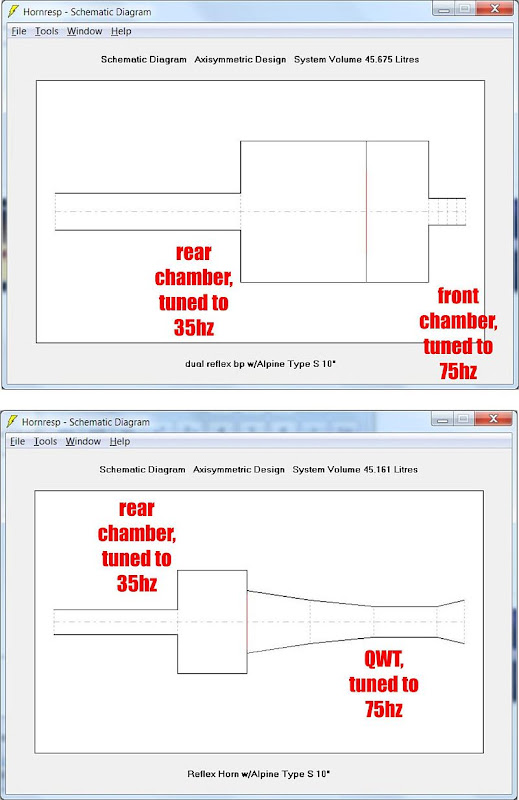
In my original post, it might not be immediately obvious what my box looks like. (And I need a name for it too! Perhaps "Single Reflex Horn?")
I hope the pic above clears this up a bit. In the pic, we see the following:
1) The rear chamber in both subwoofers is identical. It's a plain ol' vented box, consisting of a chamber and a helmholtz resonator.
2) The main difference between the two subs is in the front chamber. The first sub is a conventional dual reflex bandpass subwoofer. This means that there's a chamber and a port. The port in this pic is tuned to 75hz.
The second sub, my "single reflex horn", has a "horn" instead of a port. Technically, it's not a horn, it's a 'quarter wave tube' or a 'quarter wave resonator.' (By this definition, a tapped horn is not a horn either, it's a tapped quarter wave resonator.)
But the important thing to take away is that the length of the resonant element, or tube, is one quarter wave.
This is very important, because it has four big benefits for us. It improves the phase response of the total system, it simplifies construction, it increases airflow, and it gives us the ability to shape system response in clever ways.
As noted in the last post, my 'single reflex horn' has four advantages:
1) improved phase response versus a dual reflex bandpass
2) simplified construction
3) increased airflow versus a dual reflex or single reflex bandpass
4) the ability to shape system response. (I'll get to that shortly.)
Let's look at advantage number one, the main advantage in my mind. Improved phase response.
My hypothesis is that the single reflex bandpass will have superior phase response, because the output from the front of the cone is only shifted 90 degrees, versus the 180 degree shift of a helmholtz resonator.
In order to test this hypothesis, I modeled two boxes. One is a dual reflex bandpass, and one is a single reflex horn. If my hypothesis is correct, we should see that the dual reflex bandpass has 90 degrees more lag in the phase curve than the single reflex horn.
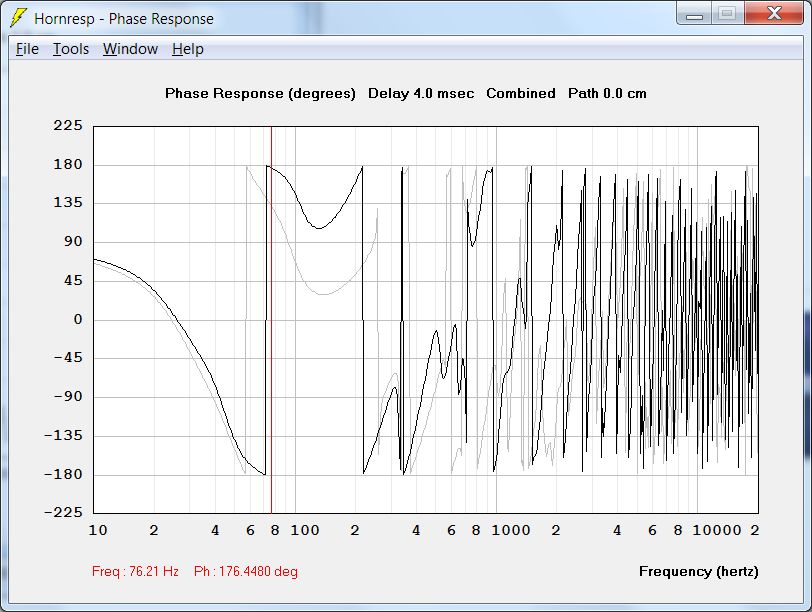
Here's the phase curve. Yes, it's ugly, but we can basically ignore everything above 200hz due to the steep rolloff. (IE, let's focus on the frequenceis that the box is used for, which is about 200hz and down.
Here's what we see:
1) The dual reflex bandpass DOES have greater phase shift. For instance, at the tuning frequency we see that the dual reflex is 45 degrees 'behind' the Single Reflex Bandpass.
2) As we go higher in frequency, the gap between the two boxes is even more apparent. For instance, at 150hz the dual reflex bandpass lags about 90 degrees behind the Single Reflex Horn
3) In the phase curve, we see that the phase of the two boxes gets closer and closer as we go lower in frequency. This is as we would expect, as the low frequency configuration of the two boxes is both identical; they're both helmholtz resonators tuned to 35hz. The important difference is *above* 35hz, where the dual reflex bandpass suffers from greater phase shift.
1) improved phase response versus a dual reflex bandpass
2) simplified construction
3) increased airflow versus a dual reflex or single reflex bandpass
4) the ability to shape system response. (I'll get to that shortly.)
Let's look at advantage number one, the main advantage in my mind. Improved phase response.
My hypothesis is that the single reflex bandpass will have superior phase response, because the output from the front of the cone is only shifted 90 degrees, versus the 180 degree shift of a helmholtz resonator.
In order to test this hypothesis, I modeled two boxes. One is a dual reflex bandpass, and one is a single reflex horn. If my hypothesis is correct, we should see that the dual reflex bandpass has 90 degrees more lag in the phase curve than the single reflex horn.

Here's the phase curve. Yes, it's ugly, but we can basically ignore everything above 200hz due to the steep rolloff. (IE, let's focus on the frequenceis that the box is used for, which is about 200hz and down.
Here's what we see:
1) The dual reflex bandpass DOES have greater phase shift. For instance, at the tuning frequency we see that the dual reflex is 45 degrees 'behind' the Single Reflex Bandpass.
2) As we go higher in frequency, the gap between the two boxes is even more apparent. For instance, at 150hz the dual reflex bandpass lags about 90 degrees behind the Single Reflex Horn
3) In the phase curve, we see that the phase of the two boxes gets closer and closer as we go lower in frequency. This is as we would expect, as the low frequency configuration of the two boxes is both identical; they're both helmholtz resonators tuned to 35hz. The important difference is *above* 35hz, where the dual reflex bandpass suffers from greater phase shift.
I'd actually considered a design like this some time ago. I think I discarded it because the increase in box size wasn't worth the gains over a simple vented alignment. I'm interested in seeing what you actually come up with.
An externally hosted image should be here but it was not working when we last tested it.
It's a bit similar to the ol' Bose Wave Cannon!
But there are some very cool things we can do, thanks to Hornresp:
1) I've never heard anyone say a good thing about the Bose Wave Cannon, and I think that's like because it's *too* resonant over certain frequencies. What we need is a way to shape the overall response and phase, and we can do that, by tapering the QWT one way or the other. (IE, you can taper it to reduce the output at one frequency, expand it to do the *opposite*, or use a straight tube like Bose. A straight tube is possibly the worst, as a straight tube has a high Q resonance, like cupping your hands and speaking into a paper towel tube.)
2) Probably the coolest thing is that it opens us up to a lot of drivers that won't work in tapped horns. For instance, I really like Alpine's new subwoofers, but they're tough to use in a horn because the high QTS creates a big ol' fat peak in a FLH, BLH or TH
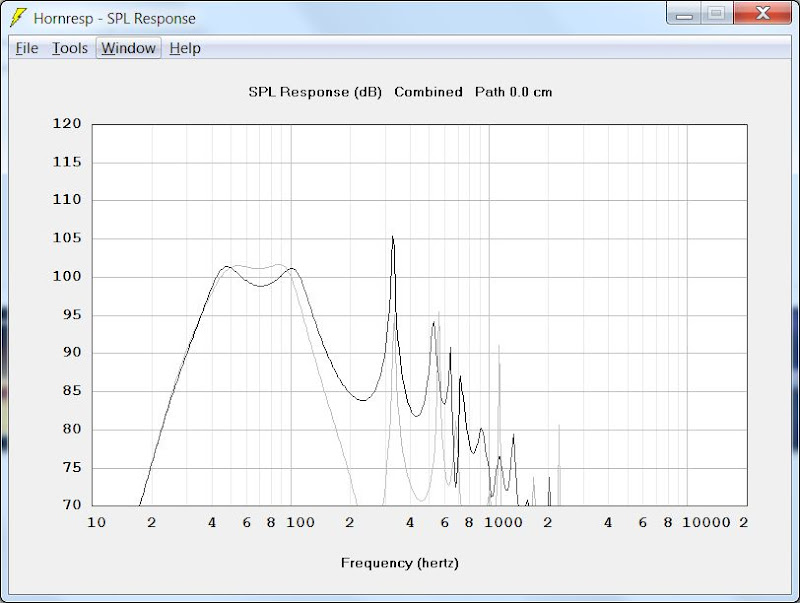
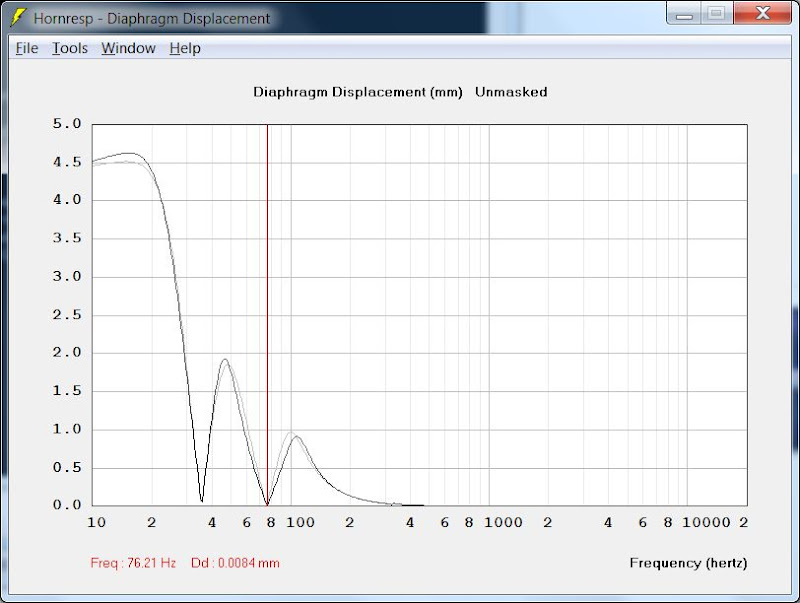

Here's the frequency response, displacement, and phase of a dual reflex bandpass versus a Single Reflex Horn. In the sims we see:
1) Ain't no cheating Hoffman's Iron Law; the F3 of the two boxes is identical, and the response is basically the same. The SRH has more high frequency output because there's no coupling chamber to roll off the highs.
2) Displacement is virtually identical. Both are tuned to the same frequencies, so this is expected.
3) As noted in post #2, the phase response of the Single Reflex Horn 'lags' less than the Dual Reflex Bandpass.
Here's another way to look at the phase response. The subwoofer covers two octaves, and in the octave of 35hz to 70hz, the two boxes are virtually identical. But in the octave from 70hz to 140hz the phase response of the Single Reflex Horn fits in a window of sixty degrees, while the dual reflex bandpass has a window of 120 degrees.
Which begs the question - is this audible?
That's a huge can of worms, but I have personally noticed that I am very sensitive to phase problems. For instance, I haven't heard a subwoofer that sounded 'tighter' than my clone of the TH-Mini. That 'tightness' may be a factor of it's frequency response. But it's frequency response isn't that great really (there's a big peak at 150hz.) But it's phase is very very good, fitting in a window of about 45 degrees in the octave from 50 to 100hz.
Before I get into frequency response shaping, let me take a minute to explain why I'm going to all this trouble.
The main reason that I am doing this is that a lot of my favorite drivers don't work in horns.
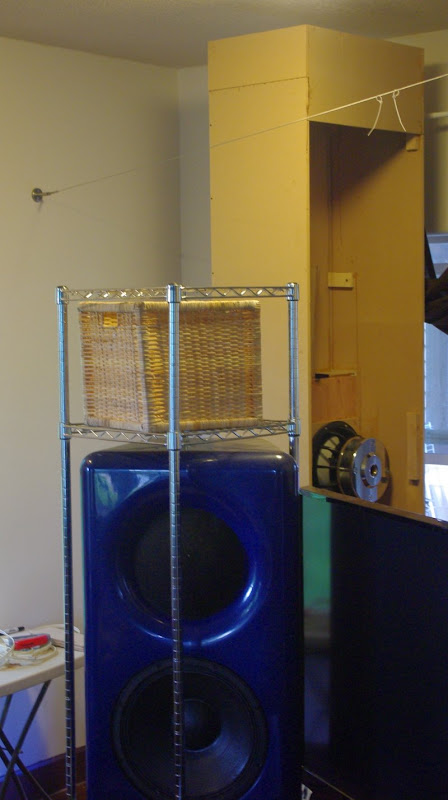
A few years back I build a 10hz tapped horn, and it was an excellent example of what I mean. The driver is fantastic, but due to the high qts horn size becomes GINORMOUS. No joke, this sub is bigger and heavier than a refrigerator.
To give you an idea of what I mean, let's compare the Diyma12 to the TangBand W8 that's likely used in the TH-Spud:
FS : 28Hz vs 28Hz
QMS : 10.53 vs 7.6
QES : 0.3 vs 0.6
QTS : 0.3 vs 0.57
xmax : 12mm vs 23mm
VAS : 23L vs 42L
If we look at the specs on the two drivers, we see that both drivers will work in an infrasonic horn, due to their low FS. But the very high QTS of the Diyma12 requires a much much larger box.
Now, obviously there are a pile (pyle?) of prosound drivers which work great in horns. But there are also a lot of reasons that you might prefer to use carsound drivers in your horns:
1) Carsound drivers offer a LOT of bang for the buck. For instance Alpine has drivers for under $100 with a BL curve that's as good as a Peerless XLS. You get a LOT of woofer for your money from some of these companies
2) IMHO, a flat BL curve really improves the sound of a sub, particularly at high power. But drivers with a flat BL curve tend to have high QTS. I don't know enough about driver design to comment, but I believe this has something to do with the shorting rings and the split gaps. Something to do with 'spreading out' the motor force over the length of the driver's excursion, versus concentrating it in the spot where the cone is at rest.
3) Prosound drivers are great, but they really offer a set of specs which aren't ideal for me. For instance, I'd love it if there was a driver with specs like the B&C 12PS100, but with a lower FS. But they don't seem to exist. I don't need to hit 130dB in my house, but I *do* like the excellent phase response and low distortion of horns.
In the next section I am going to elaborate on why there are few or no inexpensive drivers which offer the following features:
1) low qts
2) lots and lots of xmax
3) a flat BL curve
Again, I am not an expert on loudspeaker driver design, so some of the comments in the next section may be off base. But here goes...
As I understand it, the reason that a driver with high QTS is 'peaky' in a FLH or tapped horn is because there's little or no air spring controlling the driver's motion at low frequency. For instance, if I take a driver like the Diyma, with a QTS of 0.57 and put it in a sealed box, the air in the sealed box acts like a spring and controls cone motion. This is particularly important at resonance, where the driver 'wants' to ring. I personally find this 'ringing' to sound offensive, makes a sub sound 'sluggish.'
Long story short, a driver with high QTS in a sealed box is a nice combination, because the air spring in the box controls cone motion.
If you put that same speaker in a vented box, it won't work so hot, because the box unloads below the tuning frequency. This DOESN'T mean that you can't use it in a a vented box; but it DOES mean that you'll need to tune the box well below the resonance of the woofer or else the box will be boomy with poor transient response. For instance, my Diyma12 works decently in a 2 cubic foot box, but even a QB3 box takes up nearly five cubic feet.
So how does all of this relate to horns? Why should you consider a single reflex horn instead of a tapped horn, front loaded horn, or back loaded horn?
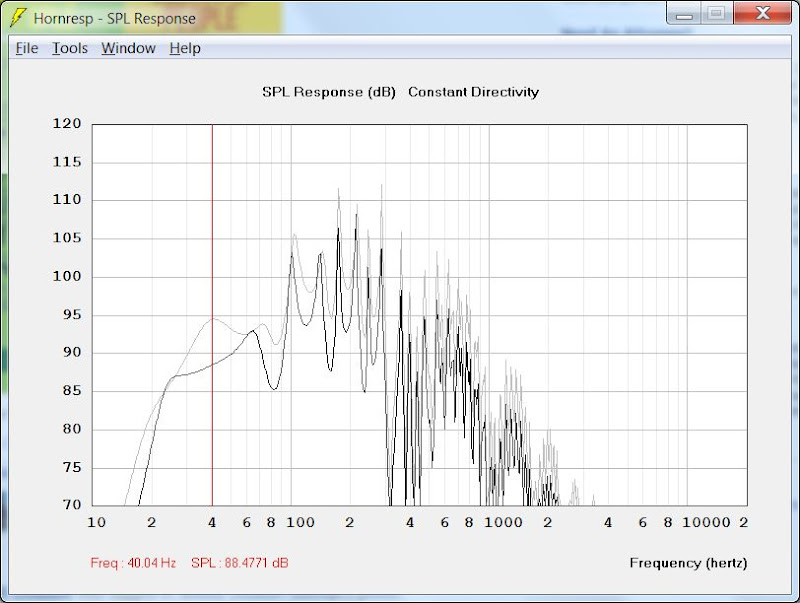
I think the pic above illustrates why you might consider a single reflex horn. In the pic above I have simulated a very small tapped horn. One of the tapped horns uses a single Alpine Type-R 8in woofer; the other uses an isobaric pair. In the pic, we see why it's so hard to use high QTS woofers in horns. The problem is that the big heavy cone 'dominates' the sound of the horn at the driver's resonance. In the pic I've placed my cursor at 28hz, the driver's resonance, and we see the following:
1) the high Q of the driver causes a big resonant peak at FS. That peak wouldn't be a huge deal in a sealed box or a dipole, but in a horn it's a real problem
2) As I understand it, the fundamental problem is that the motor of the woofer doesn't have enough force to control the cone. This is why going isobaric reduces the peak. We can see this by evaluating the parameter "BL/sqrt(re)"
For the single driver, (BL/sqrt(re)) equals 6.74.
For the isobaric pair, (BL/sqrt(re)) equals 9.52. (drivers in series.)
So we see that the increase in motor strength achieved by the isobaric pair can reduce the resonant peak, but that's not the only way to reduce it. The coupling chamber that's used in a vented or bandpass box can also be used to filter out the resonant peak.
Another way to look at the isobaric option is to look at it like this:
We usually go isobaric because we're trying to reduce box size. But another way to look at it is that isobaric loading reduces the *peak* which is created by a box that's too small. For instance, let's say your box is too small, and due to that there's a five dB peak at 40hz. By going isobaric and keeping the box size the same, NOT reducing it, we reduce that peak. (Because motor strength has gone up.)
The main reason that I am doing this is that a lot of my favorite drivers don't work in horns.

A few years back I build a 10hz tapped horn, and it was an excellent example of what I mean. The driver is fantastic, but due to the high qts horn size becomes GINORMOUS. No joke, this sub is bigger and heavier than a refrigerator.
An externally hosted image should be here but it was not working when we last tested it.
An externally hosted image should be here but it was not working when we last tested it.
To give you an idea of what I mean, let's compare the Diyma12 to the TangBand W8 that's likely used in the TH-Spud:
FS : 28Hz vs 28Hz
QMS : 10.53 vs 7.6
QES : 0.3 vs 0.6
QTS : 0.3 vs 0.57
xmax : 12mm vs 23mm
VAS : 23L vs 42L
If we look at the specs on the two drivers, we see that both drivers will work in an infrasonic horn, due to their low FS. But the very high QTS of the Diyma12 requires a much much larger box.
Now, obviously there are a pile (pyle?) of prosound drivers which work great in horns. But there are also a lot of reasons that you might prefer to use carsound drivers in your horns:
1) Carsound drivers offer a LOT of bang for the buck. For instance Alpine has drivers for under $100 with a BL curve that's as good as a Peerless XLS. You get a LOT of woofer for your money from some of these companies
2) IMHO, a flat BL curve really improves the sound of a sub, particularly at high power. But drivers with a flat BL curve tend to have high QTS. I don't know enough about driver design to comment, but I believe this has something to do with the shorting rings and the split gaps. Something to do with 'spreading out' the motor force over the length of the driver's excursion, versus concentrating it in the spot where the cone is at rest.
3) Prosound drivers are great, but they really offer a set of specs which aren't ideal for me. For instance, I'd love it if there was a driver with specs like the B&C 12PS100, but with a lower FS. But they don't seem to exist. I don't need to hit 130dB in my house, but I *do* like the excellent phase response and low distortion of horns.
In the next section I am going to elaborate on why there are few or no inexpensive drivers which offer the following features:
1) low qts
2) lots and lots of xmax
3) a flat BL curve
Again, I am not an expert on loudspeaker driver design, so some of the comments in the next section may be off base. But here goes...
As I understand it, the reason that a driver with high QTS is 'peaky' in a FLH or tapped horn is because there's little or no air spring controlling the driver's motion at low frequency. For instance, if I take a driver like the Diyma, with a QTS of 0.57 and put it in a sealed box, the air in the sealed box acts like a spring and controls cone motion. This is particularly important at resonance, where the driver 'wants' to ring. I personally find this 'ringing' to sound offensive, makes a sub sound 'sluggish.'
Long story short, a driver with high QTS in a sealed box is a nice combination, because the air spring in the box controls cone motion.
If you put that same speaker in a vented box, it won't work so hot, because the box unloads below the tuning frequency. This DOESN'T mean that you can't use it in a a vented box; but it DOES mean that you'll need to tune the box well below the resonance of the woofer or else the box will be boomy with poor transient response. For instance, my Diyma12 works decently in a 2 cubic foot box, but even a QB3 box takes up nearly five cubic feet.
So how does all of this relate to horns? Why should you consider a single reflex horn instead of a tapped horn, front loaded horn, or back loaded horn?

I think the pic above illustrates why you might consider a single reflex horn. In the pic above I have simulated a very small tapped horn. One of the tapped horns uses a single Alpine Type-R 8in woofer; the other uses an isobaric pair. In the pic, we see why it's so hard to use high QTS woofers in horns. The problem is that the big heavy cone 'dominates' the sound of the horn at the driver's resonance. In the pic I've placed my cursor at 28hz, the driver's resonance, and we see the following:
1) the high Q of the driver causes a big resonant peak at FS. That peak wouldn't be a huge deal in a sealed box or a dipole, but in a horn it's a real problem
2) As I understand it, the fundamental problem is that the motor of the woofer doesn't have enough force to control the cone. This is why going isobaric reduces the peak. We can see this by evaluating the parameter "BL/sqrt(re)"
For the single driver, (BL/sqrt(re)) equals 6.74.
For the isobaric pair, (BL/sqrt(re)) equals 9.52. (drivers in series.)
So we see that the increase in motor strength achieved by the isobaric pair can reduce the resonant peak, but that's not the only way to reduce it. The coupling chamber that's used in a vented or bandpass box can also be used to filter out the resonant peak.
Another way to look at the isobaric option is to look at it like this:
We usually go isobaric because we're trying to reduce box size. But another way to look at it is that isobaric loading reduces the *peak* which is created by a box that's too small. For instance, let's say your box is too small, and due to that there's a five dB peak at 40hz. By going isobaric and keeping the box size the same, NOT reducing it, we reduce that peak. (Because motor strength has gone up.)
I went through a similar experiment quite awhile back... David even took pity on me and added the 'compound horn' option in hornresp as I was trying to do long horn/short horn with chambers both sides. Same thing as you are doing, except you are using a straight taper port on one side.
While working on this project, I found that the fundamental concept works. IE, you can take a dual reflex bandpass enclosure and replace one side of the box with a horn.
Where things got tricky was phase and group delay.
For instance, the explicit reason to build a box like this was to take advantage of the (theoretically) better phase response of a horn versus a helmholtz resonator. (IE, a horn theoretically has 90 degrees of phase shift, whereas a vented box has 180.)
But this is all theory, and the computer sims seem to indicate that it's one big gray area. This is likely because the 'horns' aren't really horns, due to their very small dimensions, particularly when you're trying to make the box very small.
I am going to start another thread titled 'vented versus TH sound quality' to investigate further.
Where things got tricky was phase and group delay.
For instance, the explicit reason to build a box like this was to take advantage of the (theoretically) better phase response of a horn versus a helmholtz resonator. (IE, a horn theoretically has 90 degrees of phase shift, whereas a vented box has 180.)
But this is all theory, and the computer sims seem to indicate that it's one big gray area. This is likely because the 'horns' aren't really horns, due to their very small dimensions, particularly when you're trying to make the box very small.
I am going to start another thread titled 'vented versus TH sound quality' to investigate further.
Dear Patrick
I've read your posts on TH, and I'm evaluating the possibility of realize a TH since I need a subwoofer (or a couple).
I'm try to understand if my CIARE PW390 can be used for it (I've a new couple unused), I report down here the spcs.
Should You suggest something to me?
I've also read about TH on "high end mid/high end" at
Martinsson's Blog - high end mid/high end
I don't need high SPL but an high efficiency and fast system, if it is possible to match with Audionirvana super 8" Nd drivers that I'm using in my system.
Thank You very much!
Ciare PW 390 WOOFER
1000 Watt max | 8 V | Ø 380 mm / 15”
Paper cone, doped NOMEX® fabric surround,
sandwich building, aluminium wire
Rated Power 500 W
Re 5,37 Ohm
D 330 mm
Impedance 8 Ohm
Fs 37 Hz
Vas 225 dm3
SENSITIVITY (1W/1m) 100 dB
Qms 12,37
BxL 18,75 Wb/m
VOICE COIL DIAMETER 100 mm
Qes 0,30
X-max 3,75 mm
AIR GAP HEIGHT 10 mm
Qts 0,29
η°3,61 %
Mms 85,2 g
Le 0,71 mH
Cms 0,22 mm/N
http://www.ciare.com/pdf/catalogo/PW390.PDF
I've read your posts on TH, and I'm evaluating the possibility of realize a TH since I need a subwoofer (or a couple).
I'm try to understand if my CIARE PW390 can be used for it (I've a new couple unused), I report down here the spcs.
Should You suggest something to me?
I've also read about TH on "high end mid/high end" at
Martinsson's Blog - high end mid/high end
I don't need high SPL but an high efficiency and fast system, if it is possible to match with Audionirvana super 8" Nd drivers that I'm using in my system.
Thank You very much!
Ciare PW 390 WOOFER
1000 Watt max | 8 V | Ø 380 mm / 15”
Paper cone, doped NOMEX® fabric surround,
sandwich building, aluminium wire
Rated Power 500 W
Re 5,37 Ohm
D 330 mm
Impedance 8 Ohm
Fs 37 Hz
Vas 225 dm3
SENSITIVITY (1W/1m) 100 dB
Qms 12,37
BxL 18,75 Wb/m
VOICE COIL DIAMETER 100 mm
Qes 0,30
X-max 3,75 mm
AIR GAP HEIGHT 10 mm
Qts 0,29
η°3,61 %
Mms 85,2 g
Le 0,71 mH
Cms 0,22 mm/N
http://www.ciare.com/pdf/catalogo/PW390.PDF
This do fine in tapped horn.
You need a strong motor long trow, heavy mms and low qts for TH.
With heavy mms you need automatic a big magnet, and even then it is not so high spl watt (86 dB) but
get easely to 95 to 98 dB watt with TH..
MCM Audio Select 8'' High Excursion Woofer - 120W RMS 4ohm | 55-2421 (552421) | MCM Audio Select
You need a strong motor long trow, heavy mms and low qts for TH.
With heavy mms you need automatic a big magnet, and even then it is not so high spl watt (86 dB) but
get easely to 95 to 98 dB watt with TH..
MCM Audio Select 8'' High Excursion Woofer - 120W RMS 4ohm | 55-2421 (552421) | MCM Audio Select
- Status
- This old topic is closed. If you want to reopen this topic, contact a moderator using the "Report Post" button.
- Home
- Loudspeakers
- Subwoofers
- Tapped Horn + Vented Box